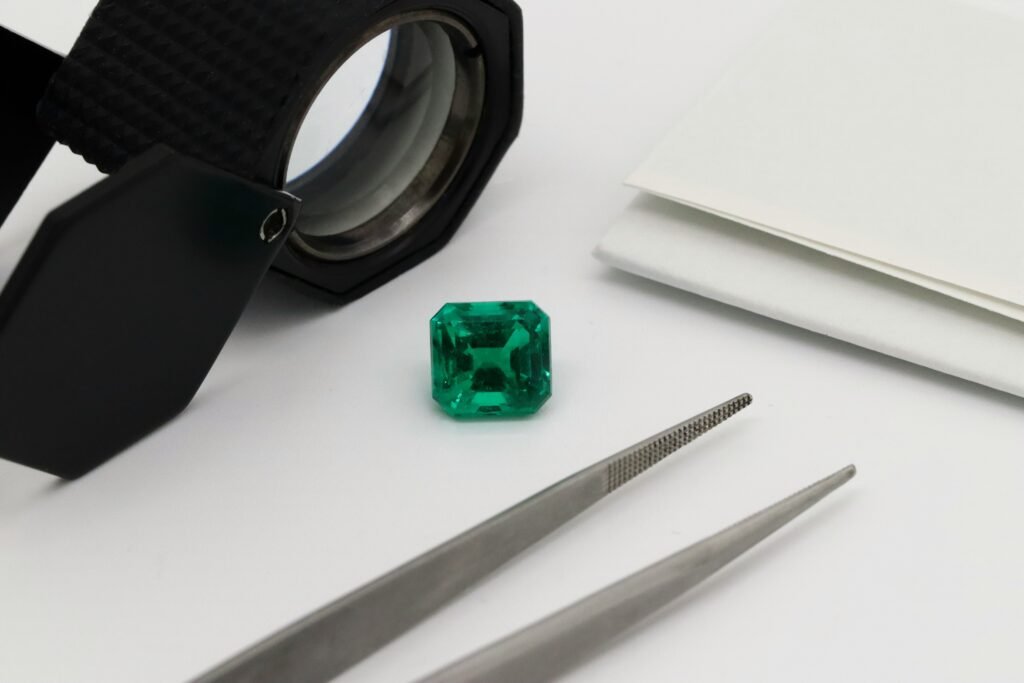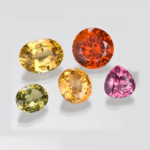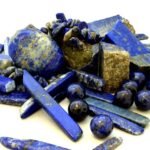What Are Green Gemstones?
Green gemstones are among the most spiritually uplifting and naturally energizing crystals in the gemstone world. They symbolize growth, renewal, abundance, and harmony. From light green gemstones like peridot to deep, dark green gemstones like emerald, these stones radiate calm and connection with nature. Popular in both metaphysical practices and jewelry design, green gemstones and crystals are believed to heal emotional wounds, attract prosperity, and balance the heart chakra. Their calming colors and deep symbolism make them perfect for meditation, daily wear, and spiritual rituals.
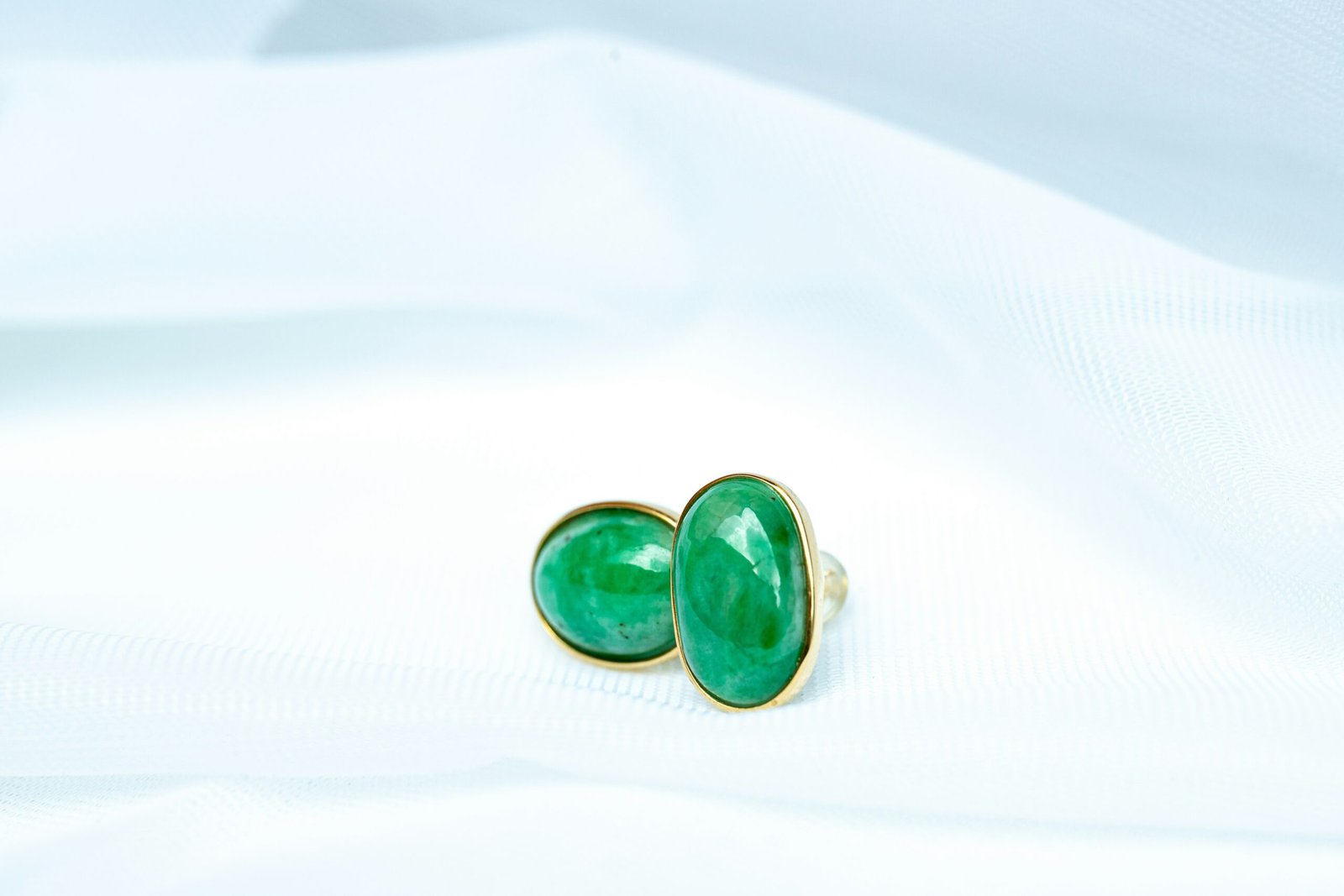
The Most Popular Green Gemstones
Emerald (Rich Deep Green)
The emerald is one of the most well-known and luxurious green gemstones in the world. Belonging to the beryl family, it features a deep, rich green color that symbolizes rebirth, love, and wisdom. Dark green gemstones like emeralds are believed to open the heart chakra and enhance emotional intelligence. Sourced mainly from Colombia and Zambia, this stunning stone is cherished for its beauty and spiritual value. Its timeless appeal makes emerald a favorite for both fine jewelry and healing work.
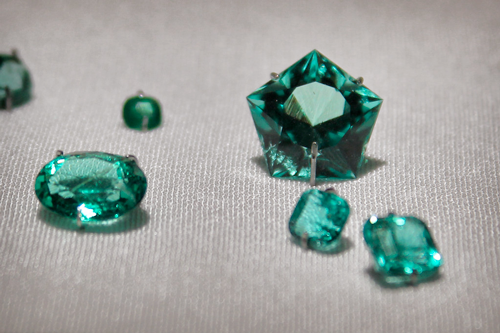
Peridot (Lime to Yellowish Green)
Peridot is a brilliant light green gemstone known for its fresh, lemony hue and strong healing energy. As a stone of compassion, peridot is said to reduce stress, anger, and jealousy, making it a popular choice for emotional cleansing. Often associated with abundance and renewal, this gem aligns with the heart and solar plexus chakras. It’s one of the few gemstones formed deep in the Earth’s mantle and brought to the surface by volcanic activity.
Green Aventurine (Translucent to Opaque Forest Green)
Green aventurine gemstone is widely used for its calming and luck-attracting qualities. Recognized as the “Stone of Opportunity,” it’s ideal for manifesting prosperity and promoting well-being. With its shimmering appearance and gentle energy, green aventurine is often featured in green gemstones healing practices. It is considered excellent for heart chakra alignment and is commonly found in jewelry, tumbled stones, and crystal grids.
Green Onyx (Bright to Deep Leafy Green)
Green onyx gemstone is a soothing and protective crystal known for its smooth texture and vibrant green color. It is a symbol of restfulness and purity, offering strength during times of stress or grief. This beautiful stone is believed to promote mental clarity and emotional balance. Often used in carvings and beads, green onyx pairs well with silver or gold for unique jewelry designs.
Jade (Milky Pale to Deep Olive Green)
Jade is one of the most ancient and spiritually revered green gemstones in Eastern traditions. Known for its association with serenity, longevity, and prosperity, jade promotes harmony and emotional healing. There are many green toned gemstones, but jade stands out with its waxy texture and smooth polish. It comes in both light green and deeper emerald hues, making it versatile and highly valued in feng shui and spiritual rituals.
Malachite (Banded Bright to Dark Green)
With its intense color bands and swirling patterns, malachite is a visually striking dark green gemstone. This copper-based mineral is prized for absorbing negative energy and aiding transformation. It’s often used in green gemstones healing to protect the aura and bring emotional clarity. Due to its softness, malachite is commonly cut into cabochons and decorative carvings.
Tsavorite Garnet (Intense Grass Green)
Tsavorite garnet is a rare and valuable member of the garnet family with a brilliant, vibrant green color. Unlike many other green stones, tsavorite is untreated, which adds to its appeal. It symbolizes prosperity, vitality, and growth. This gem is perfect for collectors and anyone looking for a green gemstone with unmatched sparkle and natural intensity.
Serpentine (Light to Pale Olive Green)
Serpentine is a unique pale green gemstone known for its mottled or marbled appearance. Often linked with kundalini energy and chakra awakening, this stone is used in meditation and spiritual practice. It helps release blockages, detoxify the body, and align energy centers. Serpentine is a soft stone often used in sculptures, beads, and crystal healing tools.
Amazonite (Blue-Green to Turquoise Green)
Amazonite is a blue green gemstone that calms the spirit and soothes emotional trauma. With its shimmering aqua-green color, it bridges the energies of the heart and throat chakras. Known as the “Stone of Courage and Truth,” amazonite promotes honest communication and self-expression. It’s often worn as a talisman for truth-seekers and creatives.
Chrome Diopside (Luminous Bottle Green)
Chrome diopside is an intense, almost neon green gemstone that comes primarily from Siberia. It’s admired for its brilliance and affordability, making it a great alternative to more expensive green stones. Chrome diopside enhances intellectual capacity and emotional strength. It’s ideal for those seeking a vivid, affordable, and powerful stone.
Prehnite (Pale Yellow-Green)
Prehnite is a translucent pale green gemstone with a soft, glowing appearance. It is known as a stone of prophecy, encouraging spiritual insight and clarity. Prehnite helps to connect the heart and will, fostering inner peace and divine connection. Its soothing green hue makes it popular in meditation and for those practicing energy healing.
Green Tourmaline (Deep Emerald to Olive Green)
Green tourmaline is a vibrant and energizing stone that ranges in shades from bright green to dark olive. It is highly regarded for balancing the heart chakra and aligning energy flows. Tourmaline is also one of the few natural green gemstones used in both high-end jewelry and spiritual rituals. It’s believed to attract success and encourage creativity.
Moldavite (Olive to Bottle Green with Natural Bubbles)
Moldavite is a rare and powerful green tektite formed from a meteorite impact. Its unique olive green color and glassy texture make it distinct among other green stones. Moldavite is known for its strong spiritual energy and is often used for transformation and awakening. It connects the wearer to higher consciousness and accelerates personal evolution.
Zoisite (Dark Green with Ruby or Black Inclusions)
Zoisite is an earthy dark green gemstone often found with ruby or black hornblende inclusions. It symbolizes growth, vitality, and emotional recovery. This stone energizes the heart chakra and brings motivation to pursue goals. Zoisite is also linked with creativity and is frequently used in meditation and healing grids.
Colombian Emerald
Colombian Emeralds are among the most beautiful and valuable gemstones in the world. Known for their deep green color, these emeralds are prized for their excellent clarity and few inclusions, making them highly sought after by jewelers and collectors. They can command high prices due to their rarity and exceptional quality.
These remarkable emeralds are found in several mines across Colombia, with the largest and most productive being the Muzo Valley, where emeralds have been mined for centuries. Other notable Colombian emerald mines include Coscuez, Chivor, and Macanal.
Colombian emeralds display a wide spectrum of colors, from light green to deep bluish-green. The most prized stones are those with a pure green color, free of secondary hues. However, all Colombian emeralds are highly valued for their beauty and rarity, making them a true treasure for collectors.
Zambian Emerald
Zambian Emeralds are some of the most beautiful and coveted gemstones in the world. Mined in Zambia, East Africa, which boasts some of the richest emerald deposits on Earth, these brilliant green stones are known for their exceptional color, clarity, and carat weight.
The finest Zambian emeralds can fetch prices exceeding $10,000 per carat at auction, making them highly valuable. Despite their high worth, they remain relatively unknown to many jewelers and collectors. However, their stunning beauty and rarity are gaining recognition, and more people are beginning to appreciate the magnificence of these remarkable stones.
Jadeite
Jadeite is a metamorphic rock that comes in a variety of colors, including green, white, lavender, and black. It is the harder of the two types of jade and has a distinct glassy or waxy luster. Imperial jade, the most prized form of jadeite, is often carved into intricate shapes and used for jewelry and sculptures.
Jadeite typically forms from basalt, a type of volcanic rock. When basalt is subjected to high temperatures, the minerals within it undergo a transformation. One of the first minerals to change is plagioclase feldspar, which turns into jadeite along with other minerals like quartz and amphibole. This process gives jadeite its unique properties and beautiful appearance.
Green Gemstones Ideal for Everyday Use
When it comes to everyday wear, durability is a key factor. Some green gemstones, such as green tourmaline, jadeite, and green sapphire, are incredibly durable and can withstand daily wear. Emeralds, while harder, are prone to chipping due to their inclusions and should be worn with care.
Tourmaline and green sapphire are excellent choices for rings, bracelets, and earrings due to their hardness and resistance to damage. For necklaces and pendants, jadeite and emeralds add a touch of elegance without being subjected to as much wear and tear.
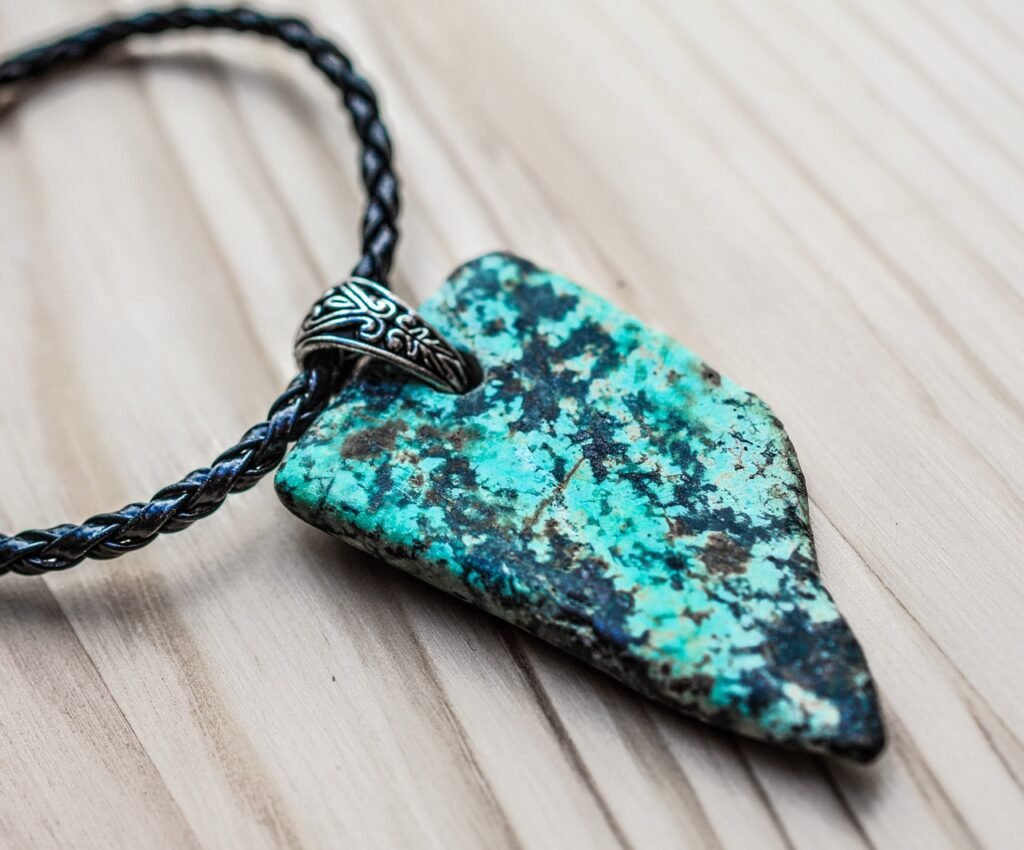
Gemstone Combinations with Green
Red and Green Gemstones
Red and green gemstones symbolize the balance between passion and tranquility. Combinations like ruby and emerald or garnet and green tourmaline are not only visually striking but are also believed to harmonize the root and heart chakras. This dynamic pairing is perfect for those seeking balance between ambition and compassion.
Green and Brown Gemstones
Green and brown gemstones such as unakite and green jasper blend the grounding energies of earth with the uplifting vibes of growth and renewal. These combinations are often used for emotional recovery, stability, and spiritual detoxification. Ideal for grounding while expanding awareness.
Green and Red Gemstone
Gemstones that combine green and red hues, like ruby-in-zoisite, offer a powerful synergy of vitality and growth. These are known to enhance creativity, courage, and spiritual passion, while stabilizing emotional states. Perfect for artists and spiritual seekers.
Green Gemstones Chart
Here’s a quick reference chart of green gemstone names, colors, and common meanings:
| Gemstone Name | Color Range | Common Meaning |
|---|---|---|
| Emerald | Rich Deep Green | Love, Wisdom, Growth |
| Peridot | Lime to Yellowish Green | Renewal, Compassion |
| Green Aventurine | Opaque Forest Green | Luck, Healing, Prosperity |
| Green Onyx | Bright to Deep Leafy Green | Purity, Restfulness |
| Jade | Milky Pale to Deep Olive Green | Serenity, Longevity |
| Malachite | Banded Bright to Dark Green | Protection, Transformation |
| Tsavorite Garnet | Intense Grass Green | Vitality, Prosperity |
| Serpentine | Light to Pale Olive Green | Detox, Chakra Alignment |
| Amazonite | Blue-Green to Turquoise Green | Courage, Communication |
| Chrome Diopside | Luminous Bottle Green | Intelligence, Strength |
| Prehnite | Pale Yellow-Green | Prophecy, Peace |
| Green Tourmaline | Deep Emerald to Olive Green | Creativity, Success |
| Moldavite | Olive to Bottle Green | Transformation, Awakening |
| Zoisite | Dark Green with Ruby Inclusions | Growth, Motivation |
Popular Green Gemstone Names and Types
There are numerous green gemstone names ranging from delicate pastels to rich, deep tones. Notable types include emerald, peridot, jade, and green aventurine gemstone. These stones are revered for their beauty and metaphysical strength. Whether you prefer dark green gemstones for grounding or light green gemstones for spiritual awakening, the variety is both rich and inspiring. Many natural green gemstones also hold historical and healing value, especially when used in jewelry or energy work.
Light Green Gemstones: Freshness and Emotional Balance
Light green gemstones such as peridot, prehnite, and serpentine offer a fresh and peaceful energy. These stones are associated with emotional healing, abundance, and heart chakra alignment. Light green gemstone names often symbolize new beginnings and self-growth. They are widely appreciated in jewelry and spiritual practices for their soft yet powerful effects. Pale green gemstones like green calcite and chrysoprase also fall into this category and are ideal for those seeking inner calm.
Dark Green Gemstones: Strength, Wealth, and Wisdom
Dark green gemstones like emerald, malachite, and green tourmaline convey power, prosperity, and deep healing. These stones are linked with wisdom, strength, and protection. Dark green gemstone names are often associated with luxury and legacy, making them popular in both fine jewelry and spiritual rituals. The grounding energy of these stones connects deeply with nature and emotional balance.
Pale Green Gemstones: Subtle and Soothing
Pale green gemstones such as prehnite, green calcite, and pistachio serpentine are known for their gentle vibrations. These gems work subtly on the heart and spirit, offering peaceful energy and light healing. Pale green gemstone names are especially beneficial for empaths and energy healers. Their calming colors are also popular in boho and nature-inspired jewelry collections.
Blue-Green Gemstones: Balanced Expression and Intuition
Blue green gemstone names include amazonite, turquoise, and chrysocolla. These stones balance the energies of the heart and throat chakras, encouraging truth, creativity, and communication. They are also deeply calming, making them suitable for meditation and daily wear. The dual-tone appearance of these gems makes them stand out in both fashion and healing work.
Red and Green Gemstones: A Bold and Festive Fusion
Red and green gemstones like ruby-in-zoisite and unakite combine the passionate fire of red with the renewing calm of green. These combinations are ideal for energizing both the root and heart chakras. They are especially used during holiday seasons or for those seeking both action and compassion in one stone. Their contrasting colors are both vibrant and grounding.
Green and Brown Gemstones: Earthy Grounding and Growth
Green and brown gemstones, including unakite and moss agate, symbolize grounded growth and nature’s balance. These earthy crystals are great for emotional healing, stability, and stress relief. Their warm and cool tone combination makes them ideal for meditation and grounding energy work. They are often worn for long-term inner work and personal transformation.
Green and Red Gemstones: Creative Energy and Vitality
Green and red gemstone combinations are a dynamic fusion of healing and creativity. Crystals like ruby in fuchsite or bloodstone promote vitality, courage, and self-expression. These stones are used to awaken personal power while maintaining compassion. Their energetic synergy makes them effective in chakra healing and goal setting.
FAQs about Green Gemstones
Emerald is considered the most valuable and prestigious green gemstone due to its rarity, depth of color, and historical significance.
Green aventurine is known as the “healer’s stone” and is commonly used for emotional and heart-related healing.
Yes, most green gemstones resonate with the heart chakra, promoting love, balance, and compassion.
Jade is denser with cultural significance, while aventurine has a glittery sheen and is more common in healing practices.
Tsavorite garnet and chrome tourmaline are considered among the rarest green gemstones.
Yes, peridot is the birthstone for August and emerald is the birthstone for May.
Yes, especially stones like jade, aventurine, and green onyx, which are durable enough for daily wear.
Amazonite is a well-known blue-green gemstone known for its calming energies.
Look for natural inclusions, request certification, and consult with a gemologist or reliable seller.
They’re often used for emotional balance, growth, heart chakra healing, abundance, and spiritual grou
Conclusion
Green gemstones are timeless and versatile, with a wide range of options for every style and occasion. Whether you’re drawn to the deep, luxurious tones of emeralds or the vibrant hues of green tourmaline, there’s a green gemstone that’s perfect for you. Understanding their unique qualities, meanings, and uses will allow you to choose a gemstone that not only looks stunning but also resonates with your style and energy.
